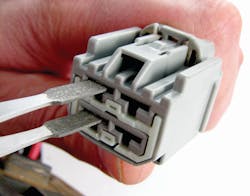Tech Tip: The three levels of contact care
Corrosion buildup on electrical connectors inevitably leads to electrical component and circuit failures. With technicians reporting corroded terminals on vehicles less than a year old, it’s imperative for any shop to have the tools necessary to combat these issues. While everyone is familiar with battery terminal cleaners, the term “contact care” was introduced to the industry seven years ago when Innovative Products of America (IPA) saw a need for contact care on a wide range of connectors. The result is a line of cleaning tools that clean and renew all connectors including male, female, spade and round. Contact care is a general term to describe corrosion prevention and maintenance on all types of electrical systems, including flat/spade, round and bullet type pins. The concept behind contact care involves servicing three levels of corrosion.
Level 1: Preventive maintenance should be performed periodically but especially any time mating harnesses or terminals are separated. This includes checking pins for tightness and applying a corrosion inhibitor, such as dielectric grease or DeoxIT Contact Cleaner and Shield, to remove any microscopic corrosion.
Level 2 (most common): Removing visible corrosion for diagnostic troubleshooting or rejuvenating a terminal to like-new condition before reconnecting. A common mistake is using improper tools such as screwdrivers, knives, emery cloth and welding tip cleaners which can stretch, deform or break pins leading to more costly repairs. Although cleaning terminals can be tricky, especially on smaller male and female pins, it is easily accomplished using the right tools for the job. A good example is IPA’s #8040 Diamond-Tip Electrical Terminal Cleaners for cleaning flat-type pins. Once corrosion is successfully removed, a corrosion inhibitor should be applied.
Level 3: Replacing a terminal that is too corroded to save. In these instances, you would need to identify the correct pin replacement number or possibly replace an entire harness. For a single pin replacement, you can use one of the many kits of terminal release tools on the market.
Using patented designs, IPA’s Contact-Care Tool Line can clean most types and sizes of electrical contacts ranging from .020 (20 Thousandths) to 1.0 (1”) found in automobiles, commercial tractors, trailers, plows, forklifts, ag and industrial equipment, etc. These tools can access many of the smallest terminals and are designed to precisely scrape corrosion from male and female pins without damaging the integrity of the terminal. These terminals are commonly used with 12V and 24V electrical systems.
Information provided by Innovative Products of America
